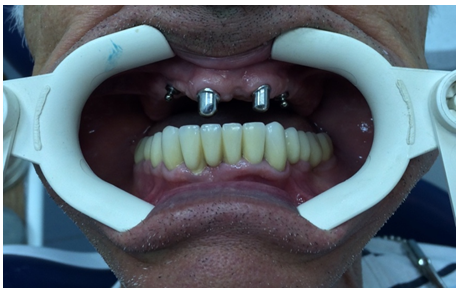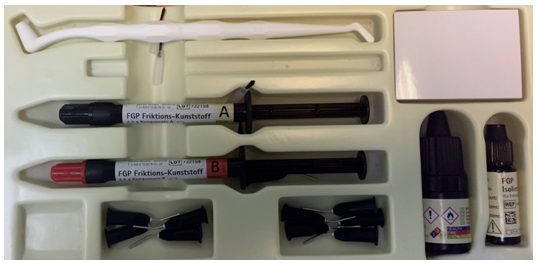ИСПОЛЬЗОВАНИЕ FGP ДЛЯ ТЕЛЕСКОПИЧЕСКИХ КОРОНОК СЪЕМНЫХ ПРОТЕЗОВ С ОПОРОЙ НА ИМПЛАНТАТЫ
Байриков И.М.1, Комлев С.С.2
1Заведующий кафедрой ЧЛХ и стоматологии, Доктор медицинских наук, Профессор, 2ORCID: 0000-0001-6491-4694, Кандидат медицинских наук, Доцент, ФГБОУ ВО Самарский государственный медицинский университет Минздрава России
ИСПОЛЬЗОВАНИЕ FGP ДЛЯ ТЕЛЕСКОПИЧЕСКИХ КОРОНОК СЪЕМНЫХ ПРОТЕЗОВ С ОПОРОЙ НА ИМПЛАНТАТЫ
Аннотация
В статье приведен клинический опыт применения FGP-пластмассы для телескопических коронок съемных протезов с опорой на дентальные имплантаты. Телескопические коронки используются в клинике ортопедической стоматологии для фиксации съемных протезов с опорой на дентальные имплантаты. Проводили ортопедическое лечение пациентов, 9 мужчин и 12 женщин, в возрасте 45-60 лет. Ортопедическое лечение пациентов проводили на базе кафедр ЧЛХ и стоматологии и ортопедической стоматологии ФГБОУ ВО «Самарский государственный медицинский университет» Минздрава России. Использование системы FGP-пластмассы для фиксации и точной припасовки телескопических коронок, позволило повысить силу фиксации съемных протезов с опорой на дентальные имплантаты.
Ключевые слова: телескопические коронки, съемный протез, FGP-пластмасса, дентальный имплантат.Bayrikov I.M.1, Komlev S.S.2
1Head of the Department of Maxillofacial Surgery and Dentistry, MD, Professor, 2ORCID: 0000-0001-6491-4694, MD, Associate Professor, Samara State Medical University Ministry of Health of Russia
USE OF FGP FOR TELESCOPIC CROWNS OF OVERDENTURE RESTORATION SUPPORTED BY IMPLANTS
Abstract
The article presents clinical experience of using FGP-plastics for telescopic crowns of overdenture restoration supported by dental implants. Telescopic crowns are used in clinic and orthopedic dentistry to fix overdenture restoration supported by dental implants. In order to perform the analysis we conducted orthopedic treatment of patients, 9 men and 12 women, aged 45-60 years. Orthopedic treatment of patients was carried out on the basis of oral surgery, dentistry and orthopedic dentistry departments of the FSBEI of Higher Education “Samara State Medical University” of the Ministry of Health of Russia. Usage of FGP-plastic system for fixation and accurate fitting of telescopic crowns enabled us to increase the fixation strength of overdenture restorations support by dental implants.
Keywords: telescopic crowns, overdenture restoration, FGP-plastic, dental implant. IntroductionTelescopic crowns are used in the clinic of prosthetic dentistry for fixation of removable dentures with support on dental implants. A lot of telescopic constructions differing in materials and manufacturing techniques are described in the literature. The authors who paid attention to this problem note a decrease of fixing effect during the exploitation of a removable denture with support on dental implants. The fixation force between the surfaces of the telescopic cap and telescopic crown decreases approximately in 3-4 years or later [1, 2].
The aim: to increase the fixation force between the surfaces of the telescopic cap and telescopic crown of removable denture with support on dental implants using the FGP system.
Material and methods
Orthopedic treatment of 9 men and 12 women aged 45-60 years was conducted. These patients were observed at the Departments of Maxillofacial Surgery and Prosthetic Dentistry of Samara State Medical University and Russian Ministry of Health.
Orthopedic treatment of 21 patients was conducted using FGP system to fix and accurately fit the telescopic crowns of removable dentures with support on dental implants (Patent № 2593349). 10 removable dentures with support on dental implants were made for the maxilla and 11 for the mandible.
In our work, we used the method of obtaining impressions during prosthetics on implants and teeth (Patent № 2601851) and method of manufacturing removable dentures made of thermoplastics and nylon with a metal framework (Patent № 2588488).
The condition of bone tissue and supporting teeth were examined on orthopantomograms and 3D computed tomography. Three-dimensional dental computed tomography was performed on the «Kodak 9000 3D» (digital dental computed tomograph with panoramic diagnostics function).
Results
The traditional orthopedic treatment of partial absence of teeth with distally unlimited terminal defect is the use of partial removable laminar and clasp dentures. An alternative method of treatment is the use of removable dentures with support on dental implants.
Despite significant achievements in reconstructive surgery using hard and soft tissues, the most optimal option still remains the manufacture of removable orthopedic constructions with support on dental implants.
The use of removable constructions facilitates the procuring and maintenance of oral hygiene level especially compared to permanent implant-supported restorations which has an undoubted positive effect on the stability of supporting implants and their durability in the long run.
Nylon is a flexible material and deformation of the denture occurs in case of terminal defect if supporting elements of traditional clasp denture are not used. To solve this problem, we used the technique of insertion a frame cast into the basis of removable denture which allowed to dispense the load on dental implants evenly, to be able to stabilize along the plane, to increase the fixation of denture.
Removable constructions have some obvious, primarily esthetic and phonetic advantages on the maxilla in comparison with its non-removable analogs. In such cases the most optimal option of implant rehabilitation of patients is the manufacture removable implant-supported restorations due to the possibility of restoring the structure of the lost hard and soft tissues.
FGP system was used to restore the reduced fixation force between the surfaces of telescopic cap and telescopic crown of removable dentures with support on dental implants.

Fig.1 - Patient B., 56 years old. Clinical situation: decrease of the fixation force of telescopic crowns of a removable denture with support on dental implants on the maxilla
Friktions-Geschiebe-Passung is a fixation and accurate fit system for telescopic crowns. When using this system, a plastic layer was made between two metal surfaces and increased frictional force (Fig. 2).

Fig.2 - Friktions-Geschiebe-Passung
The inner surface of telescopic crown was filed away to a depth of at least 0.2 mm, creating space for FGP-plastic. Metal surface of telescopic crown with FGP applied on it was handled in a sandblasting machine at a pressure of 4-6 bars by sand of alumina with a particle size of 50 microns. The sandblasted metal surface was cleaned of residues with compressed air so that contaminated sand did not interfere the adhesion of FGP-gel and FGP-plastic.
FGP-gel intended for the adhesion of FGP-plastic with metal was applied with a clean brush by a thin layer and dried for 4 minutes. The two-component FGP-plastic was kneaded in a 1:1 ratio without pores for 3 minutes.
Tartar, plaque, saliva were removed from the primary elements in the oral cavity and then the surface was isolated by petrolatum. When applying petrolatum, the thickness of the layer can increase. The ticker the layer, the less the fixation. The air was blown from the puster through the surface of the telescopic cap of removable denture with support on dental implants to create a uniform thin insulating layer.
A silicone impression was obtained and a super-gypsum model was made. The undercuts were checked. Unevennesses and undercuts of primary elements were isolated with silicone or wax. Undercuts of primary elements that were not isolated and covered by a secondary telescopic element obstructed the excretion of removable dentures with support on dental implants.
Retraction threads were used for the supporting teeth covered with telescopic caps. The composition filled with FGP-plastic was placed on the primary elements and patient positioned the removable denture with support on dental implants with the force of the masticatory pressure. The border of telescopic crown in the cervical zone was cleared of the excess of FGP-plastic. After 4 minutes the removable denture with support on dental implants was removed from the primary elements and injected again. After 7 minutes the FGP-plastic was finally polymerized. The removable denture with support on dental implants was extracted from oral cavity and edges of telescopic crowns were cleaned.
The relocation of secondary elements was conducted on the model made of superhard gypsum. On this purpose, an individual spoon was pre-made (Patent № 2420247). A silicone impression was obtained and a super-gypsum model was made. It was fitted with a removable denture with support on dental implants with telescopic crowns filled with FGP-plastic.
The FGP-isolater was used to check the fixation on the primary element. The thicker became the layer, the worse became the fixation of telescopic crown. The FGP-isolater was not used in the oral cavity. After extracting the removable denture with support on dental implants from the model the borders of telescopic crowns were cleaned. After curing of FGP-isolater on FGP-plastic the removable denture was placed in the running water and the isolater dissolved in it.
In case of forming of FGP-plastic pores in telescopic crown several drops of two-component system were mixed again, the telescopic crown was filled with it and positioned on a telescopic cap model covered with FGP-isolater. Patients were recommended to use traditional toothpaste and toothbrush for cleaning removable denture with support on dental implant and not to use cleaning tablets.
ConclusionThe proposed option of treatment patients with partial absence of teeth made it possible to manufacture a removable construction in such a way that it was in no way inferior than removable orthopedic constructions on the level of retention and he quality of the restoration of masticatory function, formed much more favorable conditions for providing optimal oral hygiene.
Currently, the importance of esthetic aspects of patient rehabilitation increases. From this point of view implant-supported removable restorations transcend the corresponding non-removable constructions. They provide an esthetic recovery not only of teeth, but also of soft tissues to form a common positive impression. Due to the possibility of forming an optimal contour of implant-supported removable restorations they represent a support for the lips and adjacent soft tissues, that allows to improve the esthetic characteristics significantly.
Thus, the use of FGP-plastic system to fix and accurately fit of telescopic crowns allowed to increase the fixation strength of removable dentures with support on dental implants. Results of orthopedic treatment of 21 patients attest the effective use of FGP-plastic in the clinical practice of prosthetic dentistry.
Список литературы / References
- Stock V. Retention force of differently fabricated telescopic PEEK crowns with different tapers [Text] / V. Stock [et al.] // Dent Mater J. - 2016. - Vol. 35 (4). - P. 594-600.
- Wagner C. Retention load of telescopic crowns with different taper angles between cobalt-chromium and polyetheretherketone made with three different manufacturing processes examined by pull-off test [Text] / C. Wagner [et al.] // J Prosthodont. - 2016. - Vol. 1. doi: 10.1111/jopr.12482.
